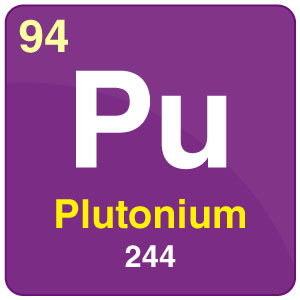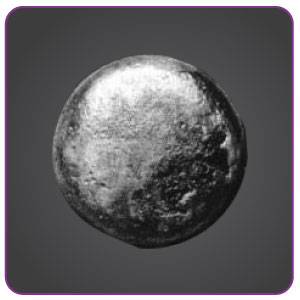Plutonium

| Symbol | Pu |
| Atomic Number | 94 |
| Atomic Mass | 244 g.mol-1 |
| Discovered by | G.T. Seaborg in 1940 |

Chemical Properties of Plutonium
| Group | Actinides | Melting point | 640°C, 1184°F, 913 K |
| Period | 7 | Boiling point | 3228°C, 5842°F, 3501 K |
| Block | f | Density (g cm−3) | 11.71 g.cm-3 at 20°C |
| Atomic number | 94 | Relative atomic mass | [244] |
| State at 20°C | Solid | Key isotopes | 238Pu, 239Pu, 240Pu |
| Electron configuration | [Rn] 5f6 7s2 | CAS number | 7440-07-5 |
| ChemSpider ID | 22382 | ChemSpider is a free chemical structure database | |
What is Plutonium?
- Plutonium is the second transuranic element with an atomic number of 94 and part of the actinide group of the periodic table.
- Plutonium is named after the planet Pluto similar to its predecessor neptunium named after the planet Neptune. It is an actinide metal with a silvery-gray appearance but when oxidised it forms a dull coating.
- This element comprises four oxidation states and six allotropes. It reacts with hydrogen and nitrogen.
- The metal tends to get warm during alpha decay, to such an extent that it is possible to boil water when the element is present in large amounts.
- Uranium is the main source of obtaining Plutonium which is obtained by the irradiation of uranium in nuclear reactors. Plutonium is generally not found in nature.
Uses of Plutonium
- Plutonium isn’t of much use in any application due to its radioactive nature.
- One of the main applications of this element is as a source of energy. It was used in the first atomic bombs.
- The element is used in nuclear weapons as it is a key fissile component and because of its easier availability and ease of fission.
- One of its isotopes, Plutonium-239 is used in new generation nuclear weapons.
Properties of Plutonium
- Plutonium forms intermediate compounds and alloys with most metals.
- Transuranium elements like Neptunium, Americium, Curium along with Plutonium are a radiological hazard and must be handled carefully with precaution.
- The resistivity of plutonium is very high at room temperature. It is high even at low temperatures.
- Plutonium increases its density when it melts by 2.5%, but it has very high surface tension and viscosity when its melting point is compared to other metals.
Certain Facts About Plutonium
- It was first produced in the year 1960. It was isolated and was used to create a nuclear bomb “Fat Man” that was dropped on Nagasaki during the second world war. The combined effect of the atomic bomb’s impact and radioactive after-effects claimed the lives of around 80,000 people.
- Plutonium pyrophoricity can cause it to look like a glowing ember under certain conditions.

Comments